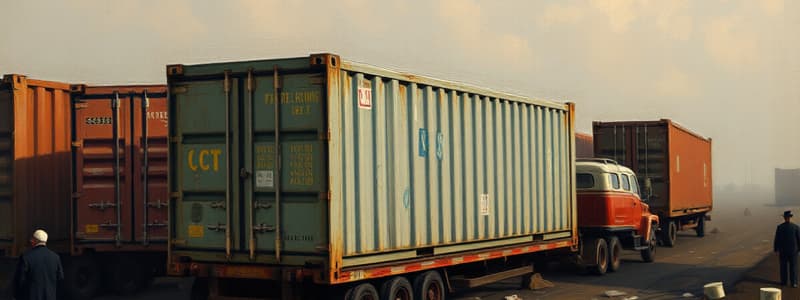Podcast
Questions and Answers
What is a key feature of insulated containers?
What is a key feature of insulated containers?
- They are used for temperature-sensitive cargo. (correct)
- They are exclusively for hazardous materials.
- They have no security features.
- They are specifically designed for bulk cargo.
Which dimension measures standardized containers?
Which dimension measures standardized containers?
- 20-foot equivalent units (TEUs) and 40-foot equivalent units (FEUs) (correct)
- 10-foot equivalent units (TEUs)
- 15-foot equivalent units (TEUs)
- 30-foot equivalent units (FEUs)
What distinguishes bulk cargoes from packaged goods?
What distinguishes bulk cargoes from packaged goods?
- They are always transported in refrigerated containers.
- They are loaded individually into containers.
- They require extensive handling during transportation.
- They are transported in large, loose quantities without individual packaging. (correct)
Which of the following is an example of dry bulk cargo?
Which of the following is an example of dry bulk cargo?
What is one advantage of intermodal compatibility of containers?
What is one advantage of intermodal compatibility of containers?
Flashcards are hidden until you start studying
Study Notes
Specialized Containers
- Insulated containers are used for transporting temperature-sensitive cargo, ensuring quality for flowable goods.
- Hazardous materials containers are specifically designed for the safe transport of dangerous substances, complying with strict regulations.
Standardized Container Cargoes
- Standardized dimensions include 20-foot equivalent units (TEUs) and 40-foot equivalent units (FEUs), allowing for uniformity in shipping.
- Intermodal compatibility enables containers to be transferred seamlessly between ships, trucks, and trains, reducing transit time and costs.
- Security features are integrated into containers to mitigate risks of theft or damage during transport.
Bulk Cargoes
- Bulk cargoes consist of goods transported in large, loose quantities, often without individual packaging, simplifying the loading and unloading process.
- Specialized equipment like cranes and conveyors is utilized to load and unload bulk cargo directly into a ship's hold.
Examples of Bulk Cargoes
- Dry bulk cargoes include agricultural products such as wheat, corn, and rice, as well as minerals like coal, iron ore, bauxite, and sand.
- Liquid bulk cargoes encompass substances like crude oil, refined petroleum products (including gasoline and diesel), edible oils, and various chemicals.
Studying That Suits You
Use AI to generate personalized quizzes and flashcards to suit your learning preferences.





